The European pine marten, scientifically known as Martes martes, is a fascinating carnivorous mammal that inhabits the forests of Europe. With its slender body, luxurious fur, and elusive nature, the European pine marten captivates the attention of nature enthusiasts and researchers alike.
This agile and resourceful species has adapted to various forested habitats, from coniferous forests to deciduous woodlands, where it demonstrates excellent climbing and hunting abilities. Its specialized diet, primarily consisting of small mammals, birds, and insects, showcases its adaptability and ecological niche within the forest ecosystem.
As a key predator, the European pine marten plays a vital role in regulating prey populations and maintaining ecosystem balance.
Despite facing historical declines in some regions due to habitat loss and persecution, conservation efforts have led to population recoveries, highlighting the importance of preserving these captivating creatures and their unique place in the natural world.
This article will delve into the world of the European pine marten, examining its appearance, habitat, behavior, conservation status, and much more. So let’s get started!
Quick Information
| Characteristic | European Pine Marten |
|---|---|
| Scientific Name | Martes martes |
| Family | Mustelidae |
| Type | Mammal |
| Order | Carnivora |
| Temperament | Generally shy and elusive, non-aggressive towards humans |
| Lifespan | Up to 18 years in captivity, typically 3-4 years in the wild |
| Size | Length: 51-54 cm (20-21 inches), plus a tail length of 22-26 cm (8.7-10.2 inches) |
| Weight | Males: 1-1.5 kg (2.2-3.3 lbs), Females: 0.7-1.2 kg (1.5-2.6 lbs) |
| Diet | Carnivorous, feeding on small mammals, birds, insects, frogs, carrion, and occasionally fruits and berries |
| Distribution | Across Europe, including countries such as the United Kingdom, Ireland, Scandinavia, France, Germany, and Italy |
| Habitat | Well-wooded areas, including coniferous and deciduous forests, woodlands, and rocky areas |
| Conservation Status | Least Concern (IUCN) |
| Fun Fact | European Pine Martens are skilled climbers and can jump between trees, using their long tail for balance. |
Appearance and Physical Characteristics
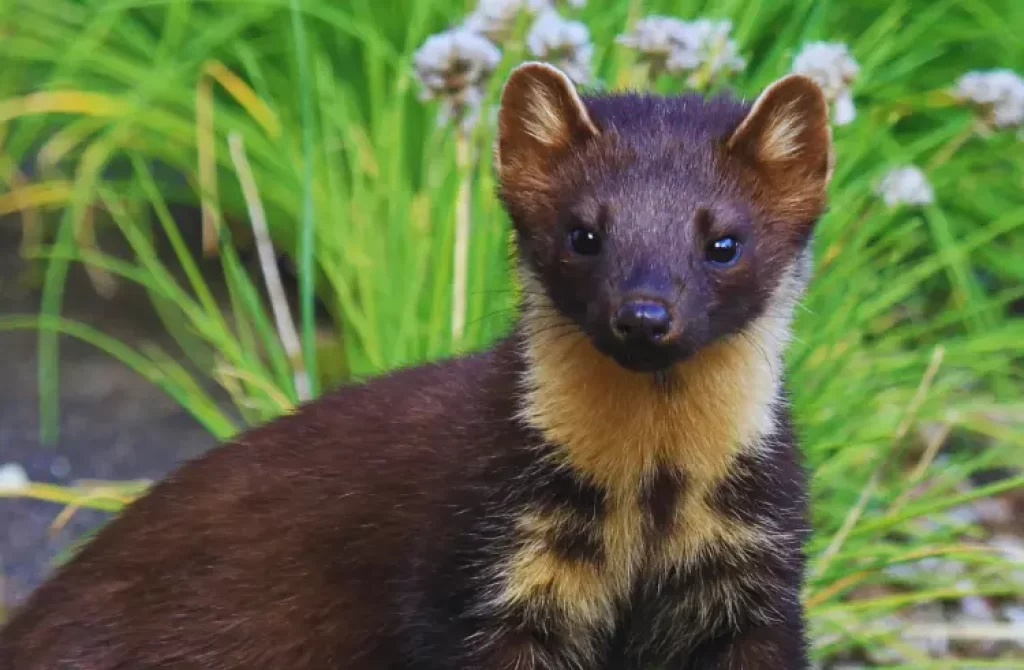
The average Length of a European pine marten, excluding its tail!
The European pine marten is a medium-sized mustelid family member known for its slender and elongated body. On average, they measure around 45 to 55 centimeters (18 to 22 inches) in length, excluding their long bushy tail. This length may vary slightly among individuals and populations.
The fur of the European pine marten
The fur of the European pine marten is a notable feature of its appearance. It is dense and soft, providing excellent insulation and protection against the elements.
The fur’s coloration typically ranges from dark brown to golden brown, creating a beautiful blend of shades that camouflages the marten in its natural habitat.
In addition to the overall color, some individuals may display a cream-colored patch on their throat or chest, known as a “bib” marking. This bib adds to the distinctive appearance of the European pine marten and can vary in size and shape among individuals.
Sexual dimorphism in European pine martens
Sexual dimorphism is evident in European pine martens, with males being slightly larger than females on average.
Adult male martens typically weigh around 1.5 to 1.7 kilograms (3.3 to 3.7 pounds), while females tend to be slightly smaller.
However, it’s important to note that there can be variations in size among individuals within the population. The size difference between males and females may be attributed to various factors, including reproductive strategies and competition for resources.
Some notable Sensory Abilities of the European Pine marten
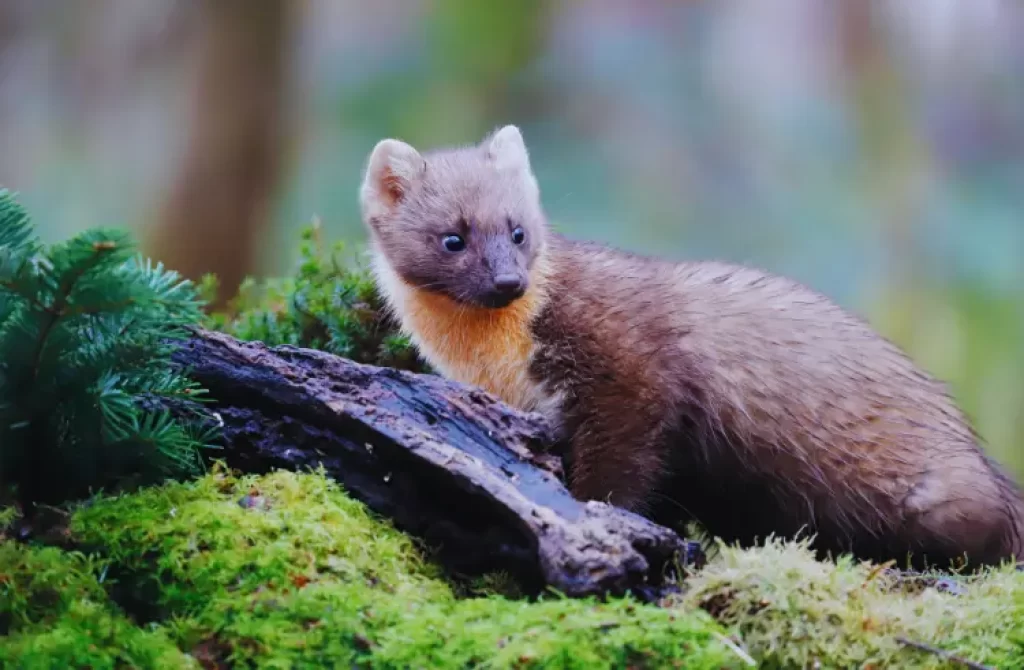
The European pine marten possesses exceptional sensory abilities, which contribute to its survival and hunting prowess.
Their keen senses of sight, smell, and hearing enable them to navigate their environment effectively and locate prey. With their sharp eyesight, they can spot movements and detect potential threats or prey from a distance.
Their acute sense of smell helps them locate food sources, mark their territory, and identify other nearby martens. Additionally, their sensitive hearing allows them to detect subtle sounds, making them aware of their surroundings and potential predators.
These sensory adaptations enhance the European pine marten’s ability to thrive in its habitat and play a crucial role in its ecological niche.
Habitat and Distribution
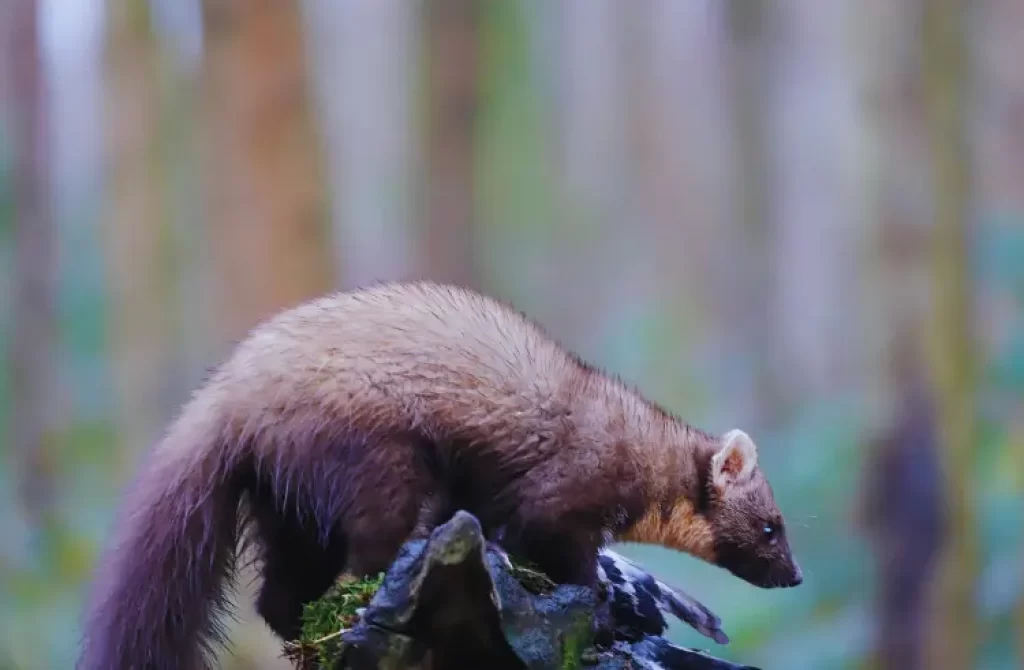
The European pine marten can be found across a wide range of habitats, including coniferous and deciduous forests, woodlands, and even rocky areas.
It is distributed throughout much of Europe, including countries such as the United Kingdom, Ireland, Scandinavia, France, Germany, and Italy. However, due to historical hunting and deforestation, its population has declined in certain regions.
Types of habitats European pine martens inhabit
European pine martens inhabit a variety of habitats across their range. They are adaptable and can be found in different forest types, including coniferous forests dominated by pine, spruce, and fir trees and deciduous forests characterized by oak, beech, and birch trees. They also occupy mixed forests that have a combination of coniferous and deciduous trees.
In addition to forests, European pine martens can be found in woodlands, scrublands, and areas with dense vegetation cover.
They are known to inhabit rocky terrains, such as cliffs and rocky outcrops, where they can find suitable denning sites. Riparian areas along rivers and streams are also frequented by pine martens, providing them with a diverse food supply.
The presence of suitable prey species is an important factor in determining the habitat suitability for European pine martens.
They rely on small mammals like voles, mice, and squirrels, which are abundant in their preferred habitats. The availability of denning sites, such as tree hollows, crevices, and ground burrows, also influences their habitat selection.
Overall, European pine martens prefer areas with a combination of suitable food sources, shelter, and cover. Their habitat requirements can vary depending on local conditions and the availability of resources, allowing them to adapt and thrive in diverse ecosystems.
In which countries is the European pine marten distributed?
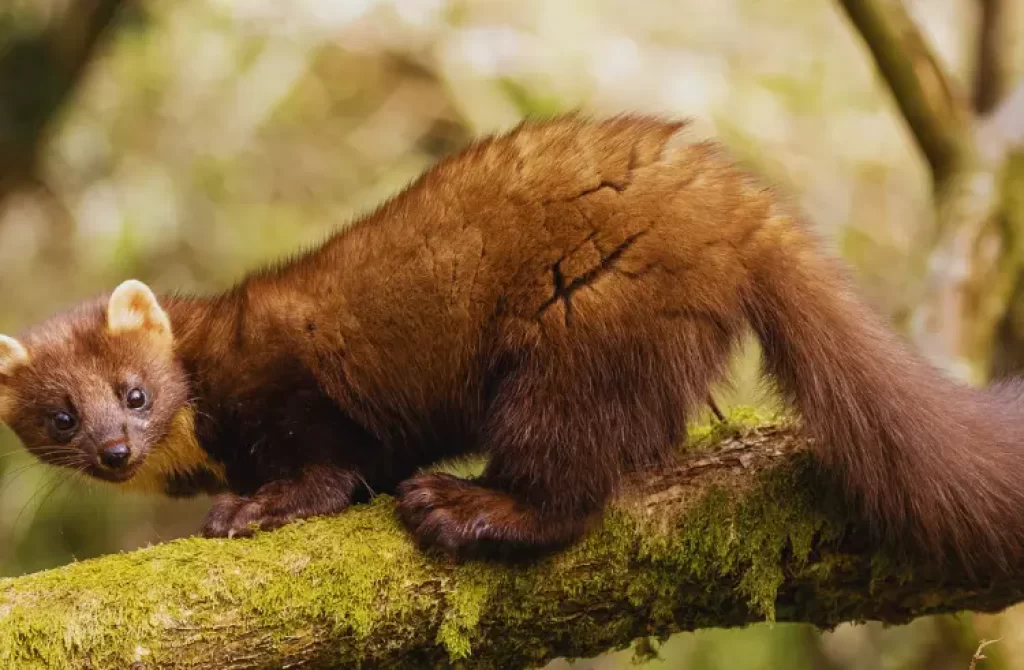
The European pine marten (Martes martes) is distributed across several countries in Europe. It can be found in:
- United Kingdom: Throughout Scotland, including the Highlands and islands, as well as parts of northern England and Wales. Their range in England is expanding.
- Ireland: Found throughout the country, with strongholds in the west and south, including areas like the Burren and Killarney National Park.
- France: Distributed across the country, including regions such as the Massif Central, Vosges Mountains, Jura Mountains, and Pyrenees.
- Germany: Widely distributed, particularly in forested areas such as the Bavarian Forest, Black Forest, Harz Mountains, and Eifel region.
- Italy: Found in various regions, including the Alps, Apennines, and parts of northern Italy.
- Norway: Distributed across the country, including regions such as Trøndelag, Telemark, and parts of northern Norway.
- Sweden: Found throughout the country, including the boreal forests of northern Sweden and regions like Värmland and Dalarna.
- Finland: Widely distributed across the country, particularly in the forests of northern and central Finland.
- Poland: Found in various regions, including Białowieża Forest, the Carpathian Mountains, and the Sudetes.
- Austria, Switzerland, Czech Republic, Slovakia, Hungary, Slovenia, Croatia, Romania, Bulgaria, and other European countries also have populations of European pine martens.
Impacts on the population of European pine martens in certain regions
The population of European pine martens (Martes martes) has been impacted in certain regions due to a combination of factors. Historically, habitat loss, deforestation, and extensive hunting for their fur led to a significant decline in their numbers.
Fragmentation of forests and habitat loss have resulted in isolated populations, limiting gene flow and increasing the risk of inbreeding. Interspecies competition and predation by larger carnivores can also affect their population dynamics.
Changes in prey populations, influenced by habitat alteration and climate change, indirectly impact the abundance and distribution of pine martens. However, conservation efforts have played a crucial role in protecting and restoring their populations.
Habitat conservation, reintroduction programs, and legal protection against hunting have contributed to many regions’ recovery and expansion of European pine marten populations. While challenges persist, these conservation measures offer hope for the long-term conservation of this fascinating species.
Expansion and reintroduction of European pine martens in some regions
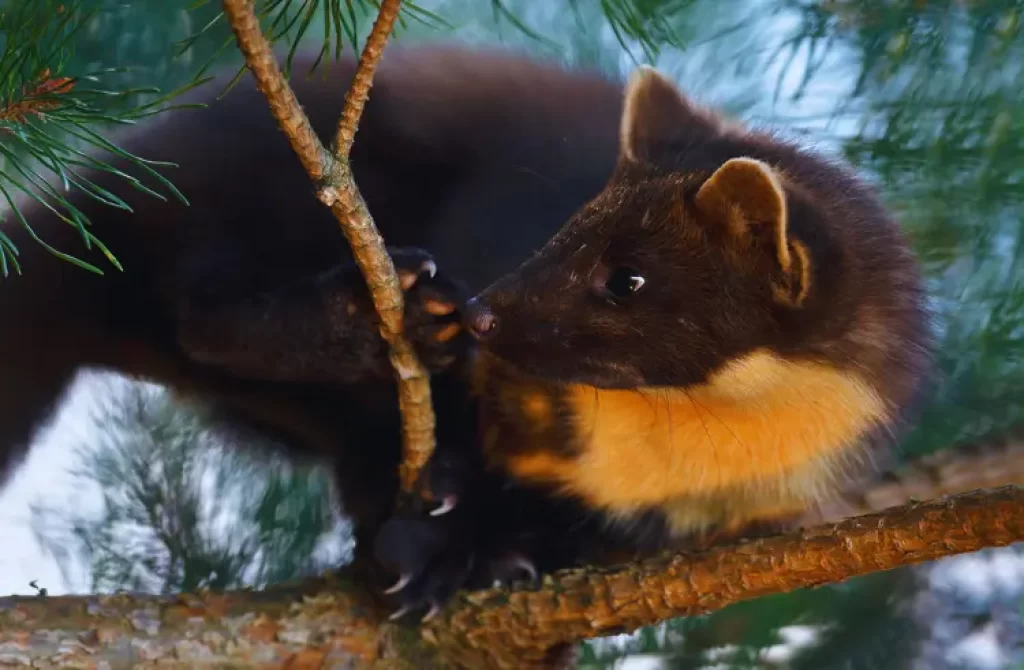
In Great Britain, the European pine marten was initially common only in northwestern Scotland. However, they have spread to other areas, including Sutherland, Caithness, Moray, Aberdeenshire, Perthshire, Tayside, and Stirlingshire. Reintroduction efforts have been carried out in places like Glen Trool Forest.
In England, pine martens were considered extinct for a long time. However, evidence of their presence, such as DNA-tested scat and photographic images, has been found in various locations, including Kidland Forest in Northumberland, Grizedale Forest in Shropshire, North York Moors in Yorkshire, and even in London.
In Wales, a small population of pine martens exists, and a reinforcement project has been initiated by the Vincent Wildlife Trust. Translocation and release of pine martens from Scotland to mid-Wales have been carried out to establish a self-sustaining population.
In Ireland, the population of European pine martens is recovering and spreading. They have traditional strongholds in the west and south, particularly in areas like the Burren and Killarney National Parks.
However, their population has significantly increased in the Midlands as well, according to studies conducted by Queen’s University Belfast.
Behavior and Diet
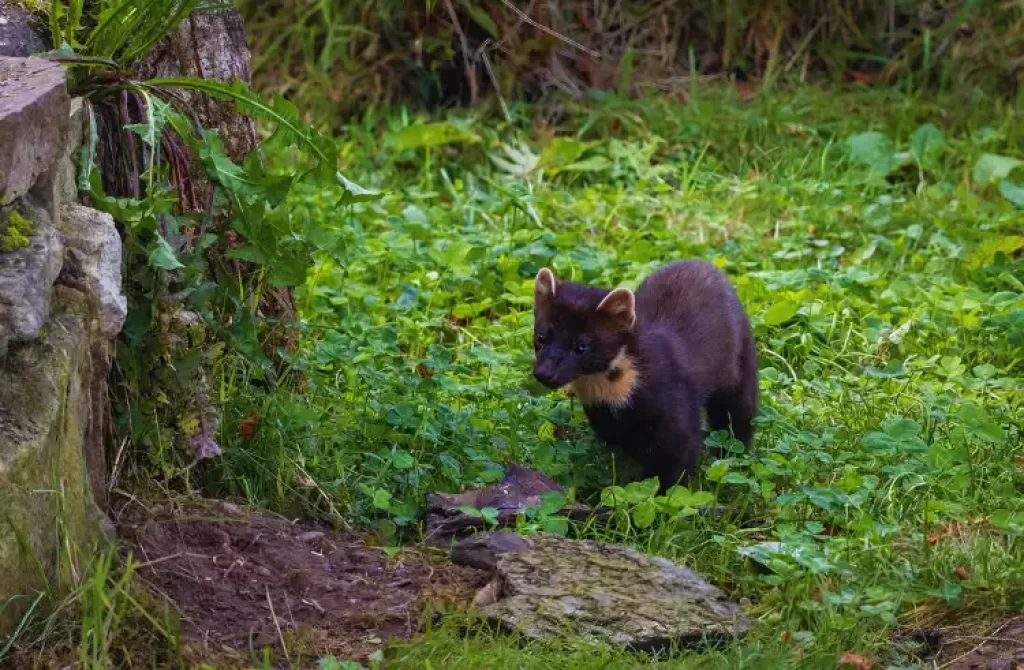
The European pine marten is predominantly active during the twilight hours, displaying crepuscular behavior. It is an agile and skilled climber, using its sharp claws and flexible body to navigate the treetops easily. Martens are known for their ability to jump between trees, utilizing their long tail for balance.
As a carnivorous species, the European pine marten primarily feeds on small mammals, including voles, mice, and squirrels. It also preys on birds, eggs, and insects, and occasionally supplements its diet with fruits and berries. This diverse diet enables the pine marten to adapt to various food sources available in its habitat.
When is the European pine marten most active?
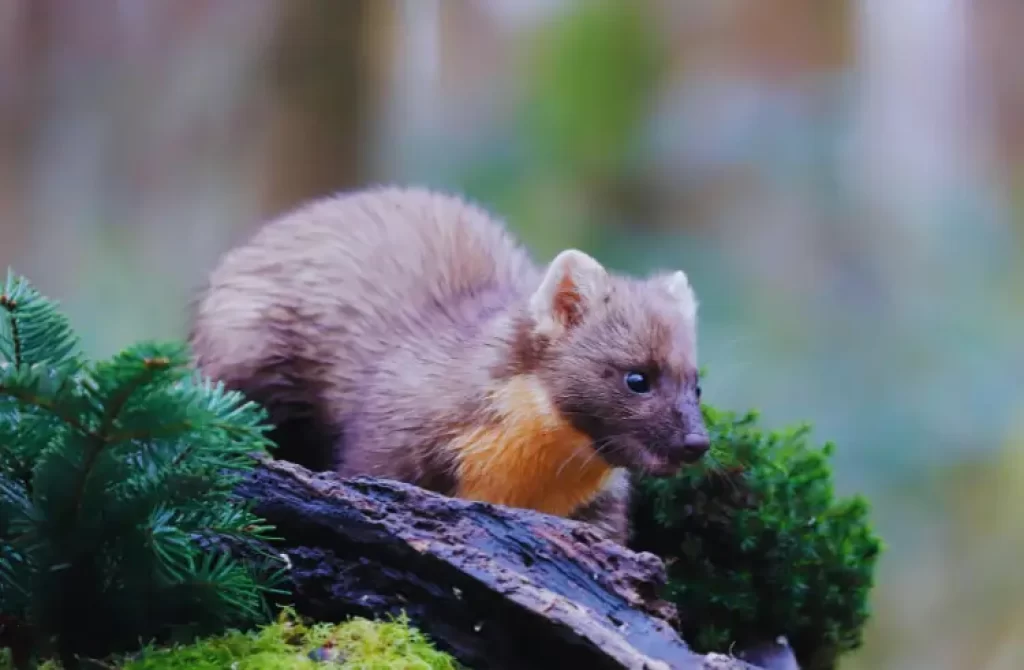
The European pine marten is primarily active during the twilight hours, which are the periods of dawn and dusk. This crepuscular behavior allows them to take advantage of the low light conditions when their main prey species are also active. During these times, the pine marten can engage in hunting, foraging, and other essential activities.
Some of the climbing abilities of the European pine marten
The European pine marten possesses impressive climbing abilities. Equipped with sharp claws and a flexible body, it can skillfully navigate through the treetops. The pine marten uses its claws to grip tree trunks and branches, allowing it to move swiftly and effortlessly.
Its flexible body enables it to squeeze through narrow gaps and leap between trees with precision. The long and bushy tail of the pine marten serves as a balancing tool, aiding in its climbing prowess.
The primary diet of the European pine marten
The European pine marten (Martes martes) is a primarily carnivorous species with a varied diet. Its diet consists of a wide range of prey, allowing it to adapt to different food sources and habitats. Small mammals, including voles, mice, shrews, and squirrels, form a significant part of their diet. These agile predators use their sharp teeth and quick reflexes to capture and subdue their mammalian prey.
In addition to small mammals, the European pine marten also preys on birds and their eggs, particularly ground-nesting birds like grouse and pheasants.
They are skilled climbers, enabling them to access bird nests in trees and prey on both eggs and nestlings. Insects, such as beetles and insects larvae, are another important component of their diet, especially during the warmer months when these invertebrates are abundant.
Pine martens are opportunistic feeders and can consume a variety of insects found in their habitat.
While the European pine marten is predominantly carnivorous, it exhibits some omnivorous behavior by incorporating plant material into its diet.
They may consume fruits, berries, nuts, and seeds when available, serving as an additional food source during certain times of the year.
This flexibility in the diet allows them to adapt to seasonal changes and fluctuations in prey availability.
Overall, the European pine marten’s diet is diverse and reflects its opportunistic hunting strategy. By targeting a wide range of prey items, they maximize their chances of finding food and sustaining themselves in their respective habitats.
List of prey and food sources of the European pine marten
- Voles
- Mice
- Shrews
- Squirrels
- Ground-nesting birds (grouse, pheasants)
- Birds’ eggs
- Insects (beetles, insect larvae)
- Fruits
- Berries
- Nuts
- Seeds
Reproduction and Life Cycle of European pine martens
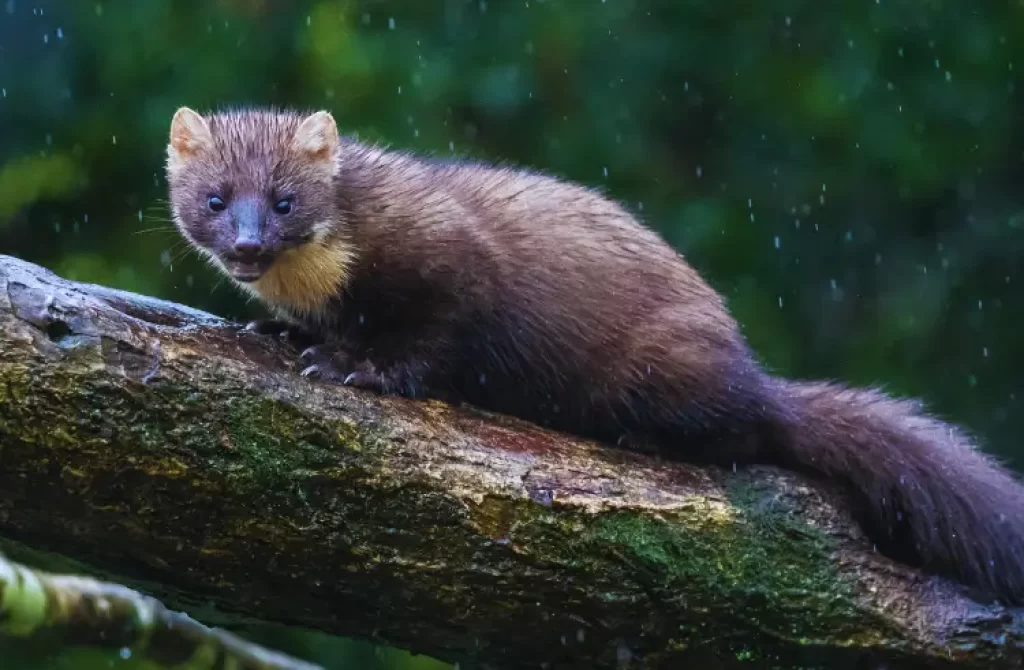
European pine martens have a lifespan that can extend up to 11 years in the wild, although the average lifespan tends to be around 3-4 years. Various factors, including predation, disease, and availability of resources, can influence their longevity.
Reproductive maturity is reached by European pine martens at the age of 2-3 years. During the breeding season, which typically occurs in late spring, courtship, and copulation take place. These interactions often occur on the ground and can last for more than an hour as part of the mating ritual.
Following successful mating, the female undergoes a gestation period of approximately one month. Around late March or early April, she gives birth to a litter of one to five young, known as kits. The kits are born in a specially constructed den that provides protection and warmth.
After spending the first few weeks of their lives in the den, the young gradually emerge and start exploring their surroundings at around 7-8 weeks of age. During this period, they rely on their mother for nourishment and guidance.
As they grow and develop, their mother teaches them essential skills, such as hunting and navigating their habitat.
Around 12-16 weeks old, the kits become independent from their mother. They start venturing out on their own, honing their hunting abilities and adapting to the challenges of their environment. This period of independence marks a significant milestone in their development as they begin to establish their territories and lead solitary lives, similar to adult pine martens.
Predators of the European pine marten
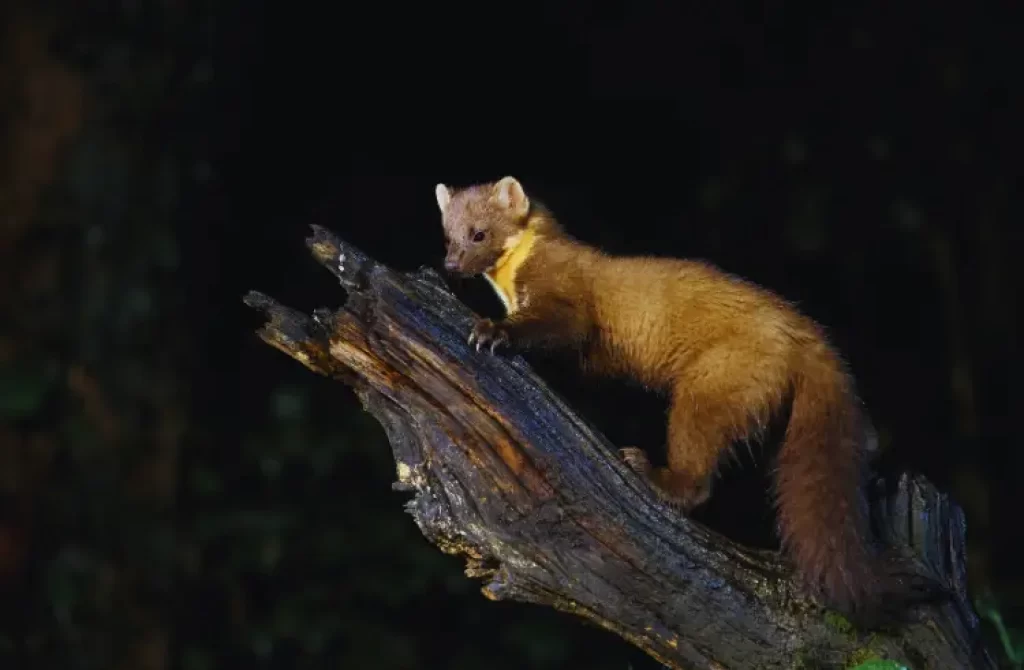
Predation is a significant threat to the European pine marten, with several larger mammalian predators and birds of prey posing a risk to their survival.
The pine marten’s predators include wolverines, red foxes, golden eagles, white-tailed eagles, northern goshawks, and Eurasian eagle owls. These formidable predators are known to target pine martens, especially young individuals.
Wolverines (Gulo gulo) and red foxes (Vulpes vulpes) are among the mammalian predators that pose a threat to pine martens.
Wolverines, with their strength and agility, can overpower and prey upon pine martens when the opportunity arises. Red foxes, being opportunistic hunters, may also target pine martens as part of their diet.
Birds of prey play a significant role in the predation of pine martens. Golden eagles (Aquila chrysaetos) and white-tailed eagles (Haliaeetus albicilla) are known to hunt and prey upon pine martens, mainly when they are vulnerable, such as during their early life stages. The powerful talons and keen eyesight of these raptors make them formidable hunters.
Additionally, the northern goshawk (Accipiter gentilis) and Eurasian eagle owl (Bubo bubo) are known to occasionally prey on pine martens. These skilled hunters can target pine martens when they are in their natural habitats.
Conservation Status and Threats
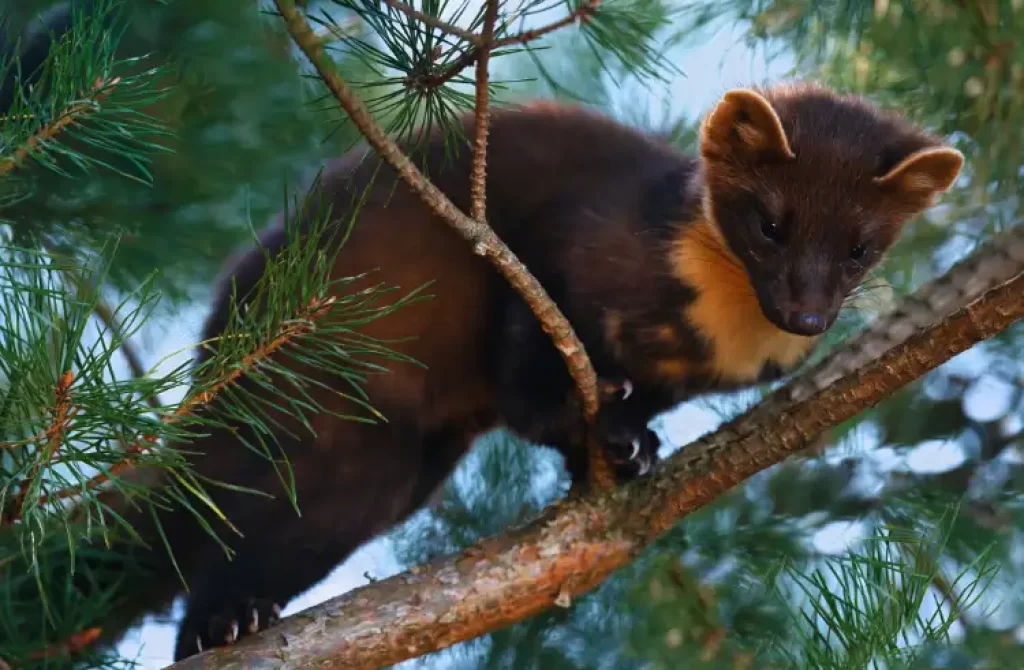
The European pine marten faces several threats to its population. Historically, it was heavily hunted for its fur, leading to population declines in many regions.
Habitat loss and fragmentation due to deforestation and human activities also pose significant challenges to their survival. However, conservation efforts and legal protection have contributed to the recovery of some populations.
In recent years, the European pine marten has benefited from increased awareness and conservation initiatives.
Efforts are underway to restore and protect its natural habitat, promote sustainable forestry practices, and reduce conflicts with human activities, such as trapping and road mortality.
The species is listed as “Least Concern” on the IUCN Red List, indicating that it is not currently at immediate risk of extinction.
Frequently Asked questions
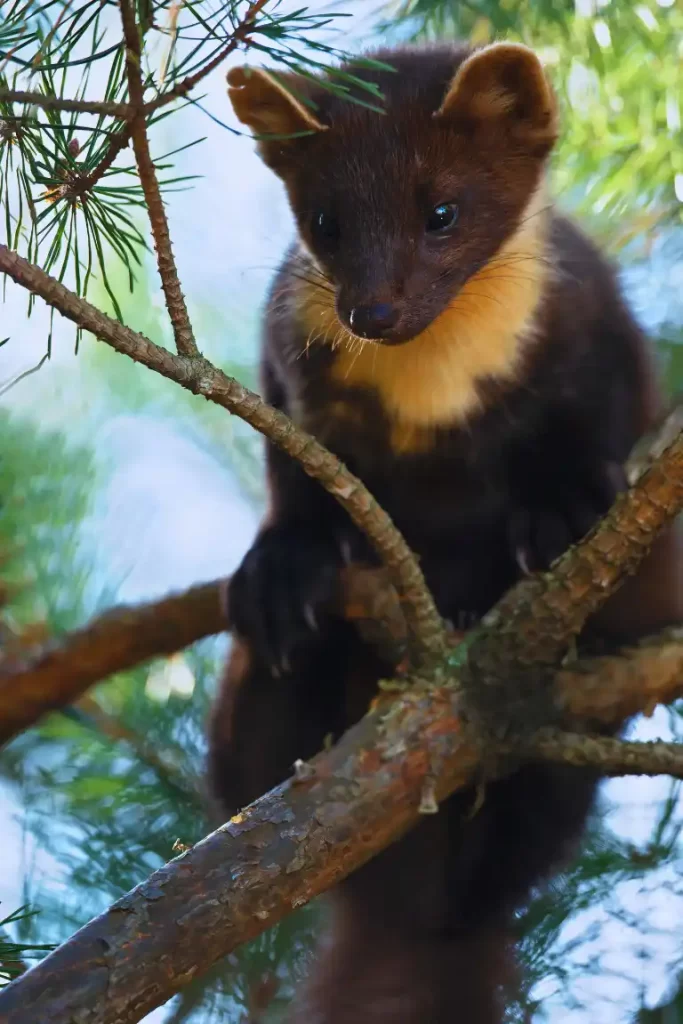
What does European pine marten eat?
The European pine marten has a varied diet, including small mammals like voles, mice, squirrels, birds and their eggs, insects, carrion, fruits, berries, and occasionally amphibians and reptiles. This carnivorous mammal is adaptable and opportunistic, relying on the availability of different food sources in its habitat.
The proportion of each prey item in its diet may vary depending on seasonal and local prey abundance. The European pine marten’s ability to exploit diverse food sources contributes to its survival and successful adaptation to different environments within its forested habitats in Europe.
Is the European pine marten an omnivore?
No, the European pine marten is primarily a carnivorous mammal. While it occasionally consumes plant material such as fruits and berries, its diet predominantly comprises animal prey. Small mammals, birds, insects, and carrion form the primary sources of nutrition for the European pine marten.
Therefore, it is considered more of a carnivore than an omnivore. Its adaptations and hunting abilities are specifically designed for capturing and consuming animal prey, making it an efficient predator in its forested habitat.
Where does the European pine marten live?
The European pine marten (Martes martes) is native to Europe and can be found across various countries. It has a broad distribution that extends from the western parts of Ireland and the United Kingdom, through mainland Europe including Scandinavia, France, Germany, and Italy, and into eastern Europe, including details of Russia. The species is adaptable and can inhabit various forested habitats, including coniferous and deciduous forests, woodlands, and rocky areas.
European pine martens prefer areas with dense vegetation cover and access to suitable prey populations. However, their people may be more localized and patchy in some regions due to habitat fragmentation and historical hunting pressures.
How big is the European pine marten?
The European pine marten (Martes martes) is a medium-sized mammal with a slender build. On average, they measure between 50 to 54 centimeters (19.7 to 21.3 inches) from head to body, with a tail length of approximately 25 to 28 centimeters (9.8 to 11 inches).
They typically weigh between 1 to 2.5 kilograms (2.2 to 5.5 pounds). However, there can be some variation in size depending on factors such as geographical location and individual genetics.
Males are generally larger and heavier than females. Despite their relatively small size, European pine martens are agile and adept climbers, allowing them to navigate their forested habitats easily.
Are pine martens dangerous?
Pine martens are not typically considered dangerous to humans. They are generally shy and elusive animals that prefer to avoid human interactions. When encountered by humans, they are more likely to retreat and find a safe place to hide.
However, like wild animals, pine martens may become defensive if threatened or cornered. In such cases, they may display defensive behaviors, such as growling or hissing, and may bite if they perceive a direct threat.
It is important to remember that wild animals should be respected and observed from a distance. If you encounter a pine marten or any other wildlife, it is best to admire them from afar and avoid attempting to touch or handle them. Feeding or trying to tame wild animals can lead to habituation and may disrupt their natural behaviors.
It’s worth noting that while pine martens are not dangerous to humans, they do play an essential role in their ecosystems. They help control populations of small mammals and contribute to the overall balance of the ecosystem. Respecting their space and allowing them to carry out their natural behaviors undisturbed is essential for their well-being and conservation.





